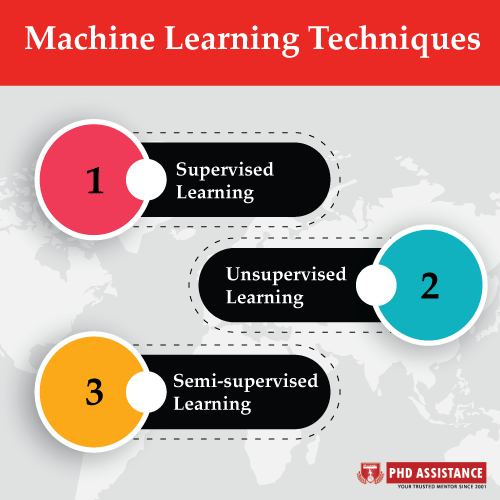Machine Learning Techniques in Python Dissertation
In-Brief
Machine Learning (ML) is a Programming Model which is quite good and faster. It helps in taking better decisions where domain knowledge is an important aspect. The Machine Learning models require some data and probable outputs if any and develop the program using the computer. Better decisions can be made using this model in the future and predictable outputs can be obtained from new inputs. Machine Learning model can be developed and deployed easily and an intelligent system is built around it that can not only monitor devices but it can be able to proactively determine potential issues and even fix those issues before it crops up.

Introduction
The most popular and significant field in the world of technology today is machine learning. Thus, there is varied and diverse support offered for Machine Learning in terms of frameworks and programming languages. There are libraries available in ML for almost all accepted Languages like Julia, C++, Python, R, Scala, etc. Python is considered an appropriate language for Machine Learning. Python- ML network has a broad collection of libraries that allow the developers to perform data extraction, transformation, and data wrangling process, and in applying robust ML algorithms and also in developing traditional algorithms easily. These ML libraries include Numpy, pandas, scipy, scikit-learn, TensorFlow, statsmodels, Keras, and so on. 1
How python is used in ML
To implement the machine learning model, a programming language must be used that is flexible, stable, and has available tools. Python has all such facilities, which is why python is used in most ML projects. From improvement to use and maintenance, Python helps software developers to be confident and productive about the software they are developing. Python has a lot of advantages that make it the best fit for Machine Learning and AI-based Dissertation like simplicity and stability, access to vast frameworks and libraries machine learning, platform independence, flexibility, and a wide community.

Python provides brief and readable code. While many versatile workflows and complex algorithms stand following machine learning, the simplicity of Python allows developers to develop consistent systems. Developers put their whole effort into solving an ML crisis instead of focusing on the scientific touch of the language. In addition to this, many developers feel that Python is very attractive as it is simple to learn. Python code is easily understandable, which makes it the easier language to develop models for machine learning.
ML Methods for Python
Ml methods can be classified based on some wide categories:
Image source: Practical Machine Learning with Python 1

- Supervised Learning: Supervised learning methods or algorithms are the most frequently used ML algorithms. This algorithm or learning method gets the data sample i.e. the training data and its related output. The main aim of the supervised learning method is to discover a relationship between input data samples and their corresponding outputs after completing various training data instances.

Image source: Practical Machine Learning with Python 1
- Unsupervised Learning: This learning method is opposite to supervised ML algorithms. In this learning method, there will not be any supervisor to grant any kind of guidance.
- Semi-supervised Learning: These kinds of methods are neither completely supervised nor completely unsupervised. They mostly fall between the two categories i.e. supervised and unsupervised learning methods. 4
Machine Learning Python Packages
There are plenty of open-source libraries that are accessible to assist in practical machine learning. These are primarily recognized as technical Python libraries and are generally used while performing simple machine learning tasks. These libraries, at a high level, can be divided into Data Analysis and core Machine Learning libraries based on their purpose.
- Data analysis packages: These sets of packages offer us the scientific and mathematic functionalities that are necessary to do data preprocessing and transformation.
- Core Machine learning packages: This set of packages provides all the essential machine learning methods and functionalities that can be useful on a given dataset for extracting the patterns. There are four key data analysis packages that are most commonly used for data analysis. NumPy, Matplotlib, SciPy, Pandas. Pandas, Matplotlib, and NumPy play a key role and are used to perform almost all data analysis tasks. 5
Future ML Topics in Python:
- A novel function for Design of VMware vSphere Automatic Operation and Maintenance System Based on Python
VMware vSphere automatic operation and maintenance work use Python features that are smart, highly-efficient, and simple, and also merges with powerful functions of modules such as pyVmomi, pysphere, and MySQLdb, and with VMware API support.
- An effective performance for Pulse-Frequency Modulation Signal Generation for Programmable Logic used by Python and VHDL system
The development and design of a signal generator circuit toolbox of pulse-frequency modulation (PFM) targeting the programmable logic device (PLD) are provided in this paper.
- A novel method for Machine Learning for Multi-objective Evolutionary Optimization in Python for EM Problems
EM problems are optimized using highly efficient algorithms which are based mostly on Python libraries and used successfully in the development of antennas.
- New-fangled mechanism for Development of Control Target Recognition intended for Autonomous Vehicle used by FPGA with Python
The FPGA Design Competition is used in autonomous vehicles on miniature roads. The ROS-based autonomous vehicle has been developed to be executed on an FPGA board as a mock car.
- An innovative method for NFDMLab: Simulating Nonlinear Frequency Division Multiplexing in Python
Fiber-optic transmission is based on nonlinear frequency division multiplexing (NFDM). NFDMLab is an open-source software used to stimulate transmissions on NFDM in Python.
Conclusion
Python provides a good blend of specialized packages, and functionalities containing Machine Learning Methods/Algorithms. Python is a language that has been used often for generating compact and readable code. Python has many libraries for statistical analysis, data manipulation, machine learning, data visualization, and deep learning. The important libraries include Pandas, NumPy, SciPy, Seaborn, Matplotlib, TensorFlow, and Scikit Learn. These libraries have made machine learning integrate easily with Python and are also simpler. As the Python community is growing quickly, multiple ML algorithms can be used with Python in the future. Linear Regression, Decision Tree, Logistic Regression, Naive Bayes, k-NN, Random Forest, Gradient Boosting Algorithms like GBM, XGBoost, LightGBM, CatBoost are the recent algorithms that can be applied to almost any data problem. 6
References:
- Dipanjan Sarkar, Raghav Bali, Tushar Sharma, 2020, Practical Machine Learning with Python: A Problem-Solver’s Guide to Building Real-World Intelligent Systems.
- 2021, Machine learning with python.
- Manohar Swamynathan, 2021, Mastering Machine Learning with Python in Six Steps: A Practical Implementation Guide to Predictive Data Analytics Using Python.
- Lisa Tagliaferri, Michelle Morales, Ellie Birbeck, and Alvin Wan, 2020, Python Machine Learning Projects.
- Michael Bowles, 2021, Machine Learning in Python – Essential Techniques for Predictive Analysis.
- Jason Brownlee, 2021, Machine Learning Mastery with Python.
 Previous Post
Previous Post Next Post
Next Post
